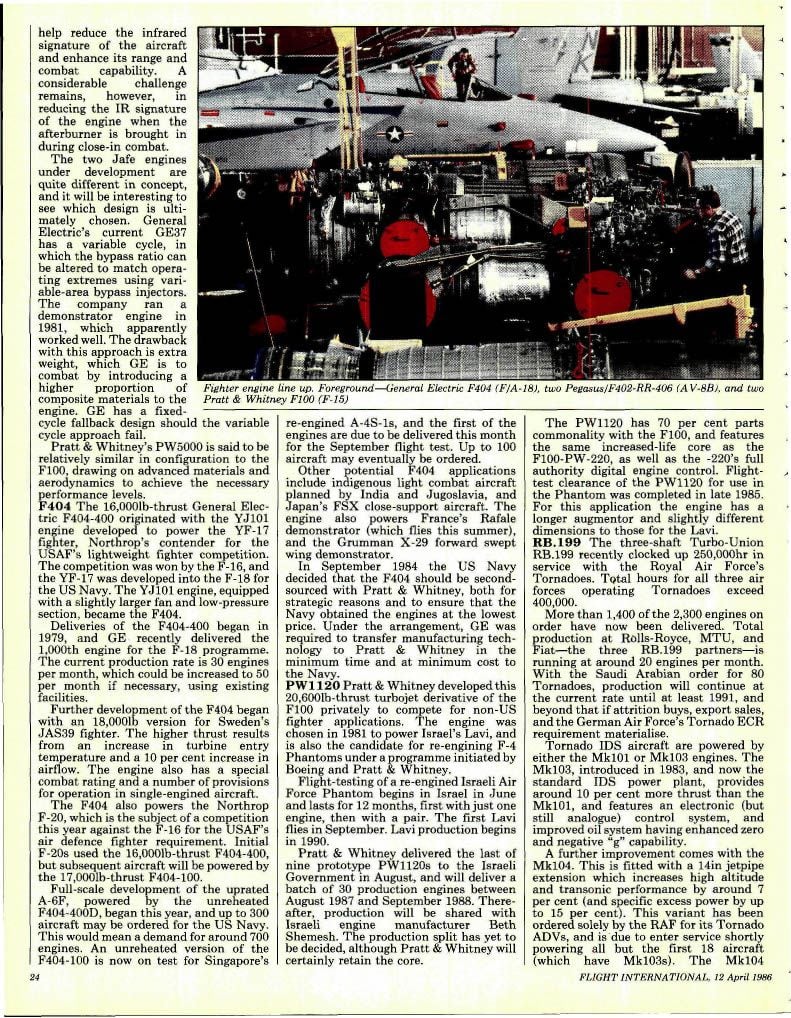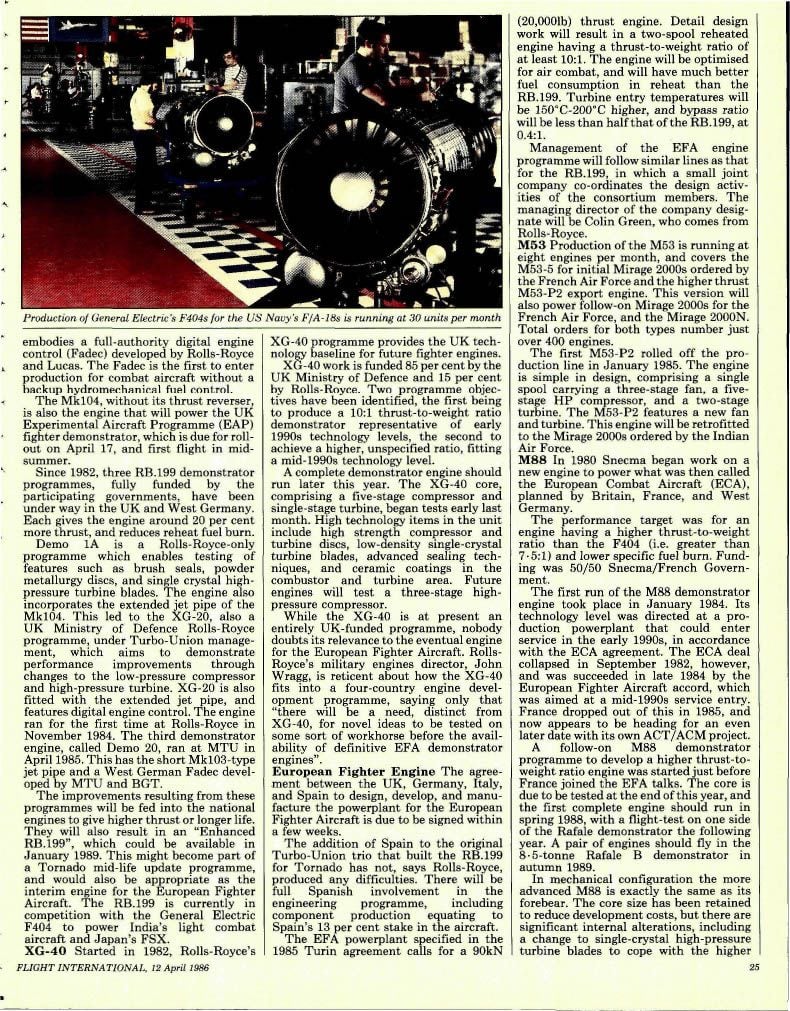Tornado F3 - asymmetric engine configuration ?
Join Date: Feb 2006
Location: Hanging off the end of a thread
Posts: 33,068
Received 2,939 Likes
on
1,252 Posts
But the laws of physics will always apply.
Join Date: Dec 2013
Location: UK
Posts: 22
Likes: 0
Received 0 Likes
on
0 Posts
Join Date: Dec 2013
Location: UK
Posts: 22
Likes: 0
Received 0 Likes
on
0 Posts
Join Date: Feb 2006
Location: Hanging off the end of a thread
Posts: 33,068
Received 2,939 Likes
on
1,252 Posts
Having done a little deep strip on the RB199 you wouldn’t get in the aircraft if you saw the state the innards got to.

Question? I'm sure the TAT probe was only down the Port intake. Not sure what it fed but why only one? Never thought about that!
Last edited by Hot 'n' High; 20th Dec 2020 at 15:16.
You have to remember the the RB199 really was pushing the boundaries of what was possible given the technology at the time and the way the aircraft was being operated. The engine itself is pretty tolerant to the thermal and mechanical loads. And of course there were two of them.
Join Date: Mar 2010
Location: Along the A43
Age: 58
Posts: 37
Likes: 0
Received 0 Likes
on
0 Posts
Left and right hand engines rotated the same way, they need airflow coming in at the optimum angle, which could have been facilitated in one intake, but not so in the other, hence the fences to present the airflow at a better angle (but with some energy losses).
We did not learn in 2 generations of aircraft that you need a convergent-divergent nozzle on a fighter jet's engines to work well at altitude. Think Spey Phantom vs J79 Phantom. RB199 vs anything. Not worth it if you stick to low level, the weight and complexity will not pay off vs the marginal advantage, but as soon as you switch from Norfolk Land Shark to fighter mode, con-di nozzle is the way.
We did not learn in 2 generations of aircraft that you need a convergent-divergent nozzle on a fighter jet's engines to work well at altitude. Think Spey Phantom vs J79 Phantom. RB199 vs anything. Not worth it if you stick to low level, the weight and complexity will not pay off vs the marginal advantage, but as soon as you switch from Norfolk Land Shark to fighter mode, con-di nozzle is the way.
Join Date: Dec 2013
Location: UK
Posts: 22
Likes: 0
Received 0 Likes
on
0 Posts
Here's the info regarding RB-199 post introduction development:


Iirc the original 'on wing' time was around 100 hours due to the original Mk101 being immature, but that grew considerably throughout the engine programme as the Mk 103/104 came into service and there were some engines which were hitting well over 1000 hours before the GR4 was scrapped. The 1980s XG engines and other varients all contributed to the success of the EJ200.


Iirc the original 'on wing' time was around 100 hours due to the original Mk101 being immature, but that grew considerably throughout the engine programme as the Mk 103/104 came into service and there were some engines which were hitting well over 1000 hours before the GR4 was scrapped. The 1980s XG engines and other varients all contributed to the success of the EJ200.
Here's the info regarding RB-199 post introduction development:


Iirc the original 'on wing' time was around 100 hours due to the original Mk101 being immature, but that grew considerably throughout the engine programme as the Mk 103/104 came into service and there were some engines which were hitting well over 1000 hours before the GR4 was scrapped. The 1980s XG engines and other varients all contributed to the success of the EJ200.


Iirc the original 'on wing' time was around 100 hours due to the original Mk101 being immature, but that grew considerably throughout the engine programme as the Mk 103/104 came into service and there were some engines which were hitting well over 1000 hours before the GR4 was scrapped. The 1980s XG engines and other varients all contributed to the success of the EJ200.
Yes the Mk101 had a number of issues. In particular the Oil System which was not all attitude and so for inverted flight, it had a couple of accumulators to maintain oil supply. That was completely revised on the 103. In order to increase on-wing life, some 101's were do- rated.
Certainly the Mk103 was a better engine in most areas but as expected, the equiaxed high pressure turbine blades still suffered from thermal fatigue.
Introduction of the single crystal blades greatly improved reliability.
Nevertheless, the engine was operated for a great deal of the time at its temperature limit due to the high proportion of time spent at low level.
Surprisingly, the GR4 programme did not include any engine enhancements despite the additional weapons capabilities.
There was another asymmetric aspect to the Mk 104 engines in the F3 and that was the surge boundaries. At the tested conditions (21 AOA in a turn, and either slam max dry to idle and when just sub-idle reslam to max dry or slam max dry to sub idle, sweep the wings by one angle change then immediately reslam to max dry) for a given standard of DECU software one engine would always surge at a consistently higher airspeed than the other ie. was the 'critical' engine for surge. However, we did see that following one software upgrade (cannot remember which one) the critical engine swapped from one side to the other with no hardware changes inside the intakes at all. I never did hear a convincing explanation for this.
There was another asymmetric aspect to the Mk 104 engines in the F3 and that was the surge boundaries. At the tested conditions (21 AOA in a turn, and either slam max dry to idle and when just sub-idle reslam to max dry or slam max dry to sub idle, sweep the wings by one angle change then immediately reslam to max dry) for a given standard of DECU software one engine would always surge at a consistently higher airspeed than the other ie. was the 'critical' engine for surge. However, we did see that following one software upgrade (cannot remember which one) the critical engine swapped from one side to the other with no hardware changes inside the intakes at all. I never did hear a convincing explanation for this.
And when you say 'sub-idle' can you recall the actual NH.
And lastly, and I apologise for testing your memory, were both engines pilot levers moved in the same way at the same time.
Thank you and thank you for your post.




 .
.